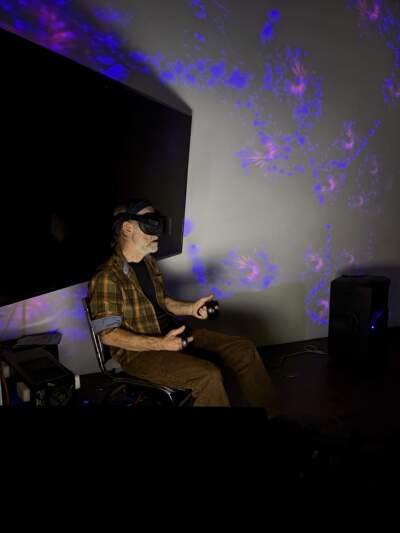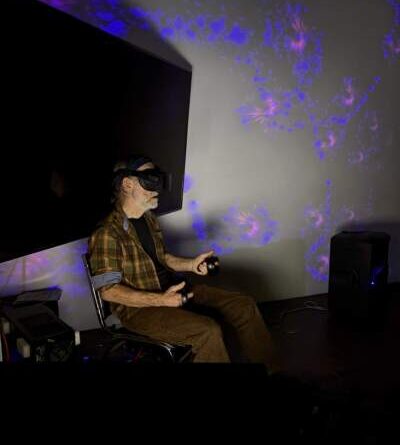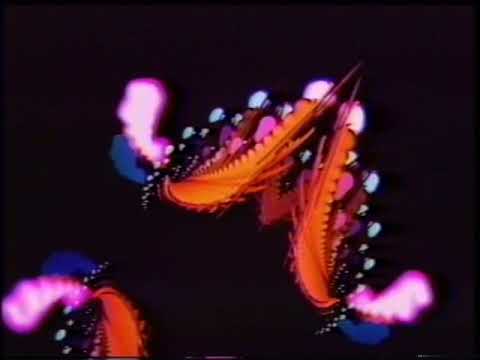Virtual reality meets music in the dream of a universal composer
On an evening in September, about 25 people filled Boston Cyberarts, a small art gallery adjacent to the Green Street stop on the Orange Line in Jamaica Plain. Trains rumbled to their feet as the audience sat, examining the real headsets placed for them on folding plastic chairs.
Bill Sebastian was sitting at the front of the gallery next to the big screen on the wall, looking futuristic with a black head and holding a ruler in each hand. The lights dimmed, and in the far corner they movedatelevangelist Julian Loida began answering questions. Sebastian raised his hands as if steering an invisible ship, and the bright images projected on the wall began to move. Vivid and phosphorescent, the transmuting figures sometimes produced familiar shapes: squid tentacles, a dragon raising its head, a cocoon-like cluster of yellow flowers. The same landscape was visible through our visors, made up of three dimensions, images seeming to pass and surround us before returning to the dark, endless landscape.

The audience was loud after the show. It was probably the first time many people encountered VR. Caleb Iyamu, a student at Boston College, summed up the experience this way: “I was like, bro, this must be God. This is madness.”
The show was the first in a series of fall concerts, dubbed the Boston Immersive Music Festival, with Sebastian and his visual synthesizer at its center. He calls his invention Outerspace Visual Communicator, or Orphans and Vulnerable.
Orphans and vulnerable children are very much Sebastian’s life work. In one sense, it is a remnant of the future of the 1970s, and in another it is an advanced application of virtual reality technology. In every sense, it is a realization of its creator’s frustration throughout his life in creating an instrument that allows him to express his feelings easily and with the same sense as music – a synthesizer that allowing him to “play” with light as if it were audible. .
Sebastian first developed the concept for Orphans and Vulnerable Children in the 1970s. Born in Texas, he came to Boston to attend the Massachusetts Institute of Technology but dropped out.
“I lived in the Fort Hill area,” Sebastian recalled in an interview. “It was just a bunch of unlikable and crazy people.”
A pianist by training, Sebastian played keys in an R&B group called the Johnson Brothers. (The group included producer Maurice Starr, who later formed New Kids on the Block, and his brother Michael Jonzun, who went on to found the pioneering hip-hop group the Jonzun Crew.) Sebastian was amazed at the way he was able to do it. he lost the flow of the process and wondered how he could expand that experience.
“As a musician, after you’ve learned your instrument for thousands of hours to play, you don’t have to think about what your hands are doing or how you’re making sounds,” he explained. “I just started thinking, like, wouldn’t it be fun to do that for the visuals?”
Sebastian, by his own admission, was “born to be an engineer.” The first OVC took him five years to create. It featured a honeycomb of colorful lights behind a 12-foot-long double-sided screen that, in its visual splendor, defied the strings. many complexities are required to strengthen it. Sebastian took advantage of the distraction by moving his hands, like paint, across the touch board while using the pedals with his feet.
At a time when rock bands were playing with laser shows and huge lighting equipment, Orphans and Vulnerables excelled. It caught the interest of Sun Ra, an early jazz artist known for his experimental and atmospheric music.
“I realized that there was only one person in the world who would understand what I was trying to achieve,” Sebastian said of the first time he saw Sun Ra perform. “It was very clear that he was going to other worlds and… communicating with these worlds.”
In the late 1970s, Sebastian performed on the OVC stage with Sun Ra and his band, developing psychedelic light as well as futuristic jazz. Both shared an understanding of the Orphans and Vulnerable as an integral part of the group, an analog image to the sax or drums.
Sebastian says: “He understood what I was doing as a musician, and he didn’t want me to just listen to music and express what I felt. “He wanted me to play something different.”
This approach sometimes led to strange moments on stage, such as when Sun Ra directed Sebastian to take a solo.
“The whole band would stop playing the sounds and the only thing that would happen would be the pictures. It was a little difficult,” Sebastian said. “You just hear everyone coughing and he jumped on the chairs and his things.”
Sebastian created an updated version of Orphans and Vulnerable in the 1980s, which was featured in two videos produced by his band Sun Ra. (An album of the then-unreleased music recorded, titled “Inside the Light World,” was released earlier this year by UK label Strut Records.)
But Sebastian dreamed of a visual experience that engulfed him completely. The development of VR headsets in the 2010s finally made that possible. After selling the technology company he founded, Sebastian set to work to build a team to help him realize his dream. Seven years later, and without much money, he created the third edition of Orphans and Vulnerable in 2018.
The combination of technology and creativity of OVCs sparked the interest of Boston Cyberarts, founded in 1996 to promote artists working in the digital space and helped launch the careers of famous multimedia artists such as Will Pappenheimer and Tamiko Thiel.
“Everything we’re trying to do, we’re trying to create examples of unique forms of interaction in art,” said Kevin Cavanaugh, chairman of the board of Boston Cyberarts. The Boston Immersive Music Festival is ambitious, running over multiple weekends from mid-September to October. 26. Each concert pairs Sebastian with a different Boston artist, from jazz saxophonists to tabla players, and on a few evenings, jams. with music recorded by his old collaborator Sun Ra.
But Sebastian didn’t intend for Orphans and vulnerable children to remain a curiosity. Although he ran out of money before he could take the product to market, his main goal was to make orphans and vulnerable children available to the community. Software can be customized, such as a sound synthesizer. Anyone can create orphans and vulnerable children from scratch.
“We thought millions of people were doing this,” Sebastian said. There will be entire markets for people to develop these things and create similar bricks and share them.
It is possible that people can use technology in a way that its creator did not intend. But Sebastian thinks others may take the challenge of identifying vulnerable children as a musical instrument. He aspires to conduct an orchestra, all 12 players are connected, each emphasizing their own feelings in the endless visual world of OVC.
#Virtual #reality #meets #music #dream #universal #composer

